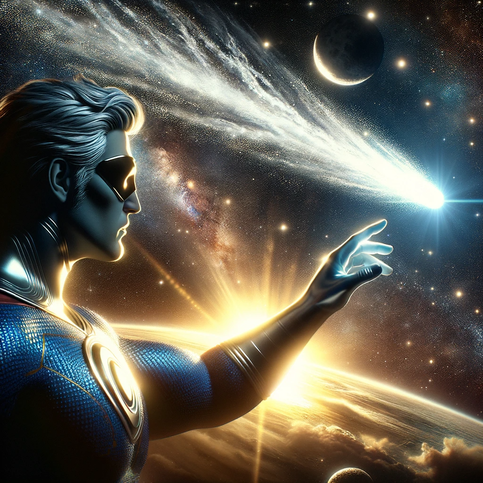Two comets are due to arrive in our skies in 2024, each one around the same time as eclipses in April and October. All comets are harbingers of change, just as eclipses are. The fact that these comets and eclipses appear around the same time is both thrilling and foreboding, stirring a mix of anticipation and apprehension among skywatchers and astrology enthusiasts alike.
“There are 101 Ketus according to some sages such as Parasara, while others like Garga say that they are 1000 in number. But sage Narada declares that there is only one Ketu which appears in manifold forms.”
Brihat Samhita by Varaha Mihira
Ketu was the word used for comets in ancient India. Later, it became synonymous with the South Node, as the word itself simply means ‘tail’. How they appear, the constellation and direction from which they appear, show what their message is.
The first comet that arrives around a total solar eclipse in April is also when we see a Jupiter-Uranus and Mars-Saturn conjunction, which means sweeping changes are in the stars. But before we get all doomy and gloomy about it, let’s look at some of the factual data.
The first comet that will likely appear in April is named the ‘Pons-Brooks’ comet and it has a rich history. It was discovered in 1812 by Jean-Louis Pons, with its orbital period initially found to be about 70 years. That seems to have been adjusted by 5 years.
In 2024, the Pons-Brooks comet is expected to make a notable return. It had an ‘outburst’ in Jul 2023, brightening significantly and exhibiting a peculiar "horned" appearance (oooh-kay).
Currently, it's in the constellation of Cygnus, a northern constellation on the plane of the Milky Way. By Mar 2024, as it gets closer to the sun, it is expected to brighten and possibly become visible to the naked eye. It may be a lot ado about nothing if it fails to deliver. This may, indeed, be a theme in 2024.
During the total solar eclipse on Apr 8, the comet and eclipse will share the skies, whether we can see either from our vantage point.
Don't Look Up!
Traditionally, people were advised not to look at eclipses for reasons other than the obvious. Even lunar eclipses were not seen (pardon the pun) as ideal for observation. It is believed the 'psychic energy' is off. It would, however, be difficult not to look up in 2024, as there is so much going on.
The closest approach of the first comet to the sun is on Apr 21, a couple of weeks after the total solar eclipse on Apr 8. The comet should be visible in the constellation of Taurus, just as Jupiter and Uranus come into an exact conjunction in the same section of the sky on Apr 20.
If there is so much going in the skies in April, there’s probably a lot going on in our lives, too. We may miss the whole ‘light show’ with the level of drama that is possible.
The second arrival in 2024 is due in October, just as we experience another set of eclipses. This one is called ‘Tsuchinshan-ATLAS’, and is likely the brighter of the two, at least according to Irish astronomer David Moore. In an interview with theJournal.ie he states it would be “at least as bright, if not brighter, than the brightest stars in the sky.”
Whether that’s good or bad news remains to be seen.
Jupiter to the Rescue!
Future civilizations may develop ways to redirect comets that may otherwise impact Earth (don’t worry, these comets are not going to hit Earth), but for now, there is no stopping them coming our way if luck were to have it.
Future civilizations may develop ways to redirect comets that may otherwise impact Earth (don’t worry, these comets are not going to hit Earth), but for now, there is no stopping them coming our way if luck were to have it.
Speaking of luck, Jupiter is said to be the only planet that can prevent Ketu from becoming destructive, according to Vedic astrology. If you have a Jupiter-Ketu conjunction (Viṣṇu Yoga) or aspect from Jupiter to Ketu, or if Ketu is placed in either of Jupiter’s signs, Sagittarius or Pisces, it mitigates Ketu's more destructive impulses to a large extent. Jupiter itself must be strong and unimpeded, of course.
Jupiter is said to be the ‘great protector’, pulling asteroids out of our orbit, preventing them from hitting Earth. Few astrologers point out, however, that Jupiter’s gravitational pull is so strong that it also actually pulls asteroids into our orbit that would have otherwise missed us by a long shot.
Perhaps it would be better to see Jupiter as a benevolent guide for the most part, who, on occasion, must become a little strict, so you are reminded to be good. Jupiter, just like Father Christmas, is making a list!
Jupiter may be benevolent but that is not always a good thing in all circumstances. Yes, we all learn and grow regardless, but Jupiter can sometimes create problems when it expands on a theme – the last Jupiter-Ketu conjunction at the end of 2019 is a case in point.
Jupiter will not conjoin Ketu again until the end of 2026. In 2024, it's aspect or sight to Ketu in Virgo, from May 2024 to May 2025, is more positive. Yet Jupiter has its own issues to deal with as it conjoins Uranus as the first comet arrives on our cosmic shores in April 2024.
How each comet appears will make all the difference. It will all make sense in hindsight, of course, as, unlike planets, we cannot know for sure how they will appear until they do. Depending on which lunar mansion the comet appears in, predictions are made about the demise of certain leaders pertaining to such asterisms.
While Ketu is correlated with Gaṇeśa, the ‘remover of obstacles’, it often removes too much, leaving us without. Certainly, Ketu removes our ignorance, whatever is taken away in a worldly sense.
Encased as we may seem to be, Ketu is freeing us from our prison.
Can I Get an Omen?
The most common collective omen that happens every six months is an eclipse, of course. The next would be a comet. These are not as common. When both occur together, on two separate occasions in the same year; well, what can I say, we’re likely to see so many changes in 2024 that leave our heads in a spin.
Speaking of heads, Ketu is said to be without one. It’s a tail. Ketu, in whatever form, eclipse or comet, brings changes that can leave us without a clear rationale. It both leaves us feeling like we are without a rudder in a worldly sense, and yet it taps us into something essential, a core being that is beyond steady in its course, even when it leaves us speechless.
This can lead to profound states of awe, tapping us into something beyond this mortal coil, but they can also leave us feeling lost, without a clear sense of direction.
The light is temporarily extinguished during an eclipse; a comet blazing across our skies pulls all focus to it, obscuring the constellation. According to some Vedic astrologers, Ketu is said to obscure and destroy the lunar mansions and planets more so, while Rahu is said to destroy the Sun, the Sun signs (rāśi), and Moon.
Usually, Ketus shows someone losing out, even if others gain. This is the story of the Lunar Nodes. Ketu is always the flipside of Rahu, i.e., indifference is the flipside of greed; destitution, the flipside of wealth.
Whatever is lost in 2024, we're all losers until everyone is free. No matter how much we may personally gain, it can never fully satisfy. No matter how much money you have, because others are without, you're not able to enjoy it fully, no matter how much you might tell yourself you can.
Ketu binds us to together. Rahu pulls us apart.
Ketu can often bring us together through calamities and events witnessed by everyone. We all see comets and eclipses at the same time; everyone is impacted in one way or another.
Brihat Samhita
Almost all comets described in Brihat Samhita are said to bring calamity, war, pestilence, famine and hardships. Occasionally, they appear to bring good news, such as an abundance of food when appearing from the north. If that is true, we may be in luck, as the first comet in 2024 is meant to appear in the northern skies. But who's north, is the question?
It cannot be north for everyone on the planet. One person's luck is another's misfortune.
The following slokas or verses from Brihat Samhita describe the potential impact of some comets based on their characteristics. Their direction and visibility, size and colour, all have an impact on the prognostication.
“The effects at all events should be declared through the rising and setting (including the particular direction thereof), position (in which part of the firmament vis-a-vis planets and asterisms), contact, the act of covering the neighbouring celestial body with a smoky mantle and colour.”
Sloka 6
“The effects of Ketu will last for as many months as the number of days during which it is visible. In the same way the number of years can be guessed from the number of months during which it is visible, the effect in all cases commencing after the first three fortnights of its appearance.
Sloka 7
“If Ketu is short, slender, clear, glossy, straight, appearing but for a short time, white, and if there be a shower closely following its appearance, it brings abundance and happiness.”
Sloka 8
“If its form bs quite the reverse of what has been stated above, it is the comet Dhumaketu and will not prove auspicious, especially when it resembles the rainbow or has two or three crests.”
Sloka 9
“There are as many Ketus rough and dark with crooked crests, appearing in the South, and portending pestilence to people and are the sons of Death.”
Sloka 12
“The single comet with three crests and colours is known as Brahmadanda and is the son of Brahman, the creator. There is no particular direction fixed for this comet and it foretells the end of the world.”
Sloka 15
Auṁ Tat Sat
References
thejournal.ie article, Comets, eclipses and meteor showers: What to watch out for in the sky in 2024:
https://www.thejournal.ie/astronomy-events-2024-6256658-Dec2023/
Chapter about Ketu in Brihat Samhita:
https://archive.org/details/Brihatsamhita/page/n145/mode/2up?view=theater


